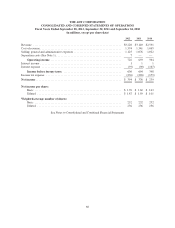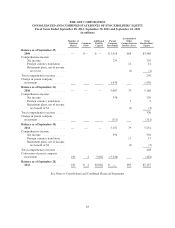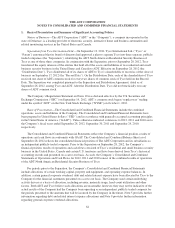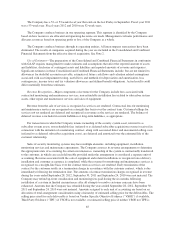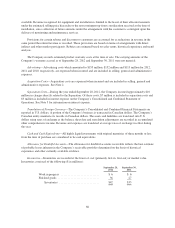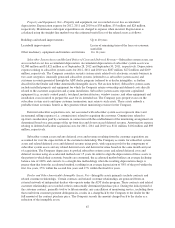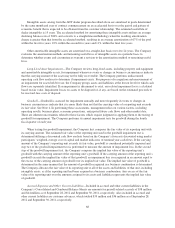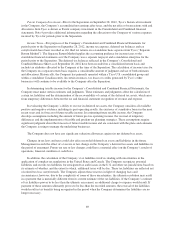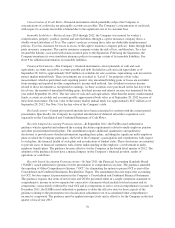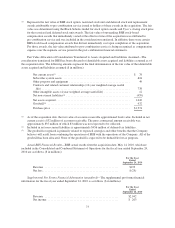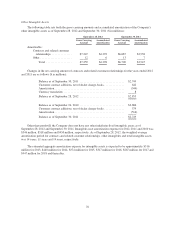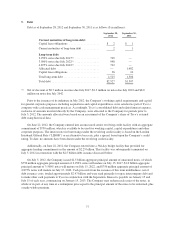ADT 2012 Annual Report Download - page 161
Download and view the complete annual report
Please find page 161 of the 2012 ADT annual report below. You can navigate through the pages in the report by either clicking on the pages listed below, or by using the keyword search tool below to find specific information within the annual report.Parent Company Investment—Prior to the Separation on September 28, 2012, Tyco’s historical investment
in the Company, the Company’s accumulated net earnings after taxes, and the net effect of transactions with and
allocations from Tyco is shown as Parent company investment in the Consolidated and Combined financial
statements. Note 9 provides additional information regarding the allocation to the Company of various expenses
incurred by Tyco for periods prior to the Separation.
Income Taxes—For purposes of the Company’s Consolidated and Combined Financial Statements for
periods prior to the Separation on September 28, 2012, income tax expense, deferred tax balances and tax
carryforwards have been recorded as if it filed tax returns on a standalone basis separate from Tyco (“Separate
Return Method”). The Separate Return Method applies the accounting guidance for income taxes to the
standalone financial statements as if the Company was a separate taxpayer and a standalone enterprise for the
periods prior to the Separation. The deferred tax balances reflected in the Company’s Consolidated and
Combined Balance Sheet as of September 28, 2012 have been recorded on a consolidated return basis and
include tax attributes allocated to the Company at the time of the Separation. The calculation of income taxes for
the Company on a separate return basis requires a considerable amount of judgment and use of both estimates
and allocations. Historically, the Company has primarily operated within a Tyco U.S. consolidated group and
within a standalone Canadian entity. In certain instances, tax losses or credits generated by Tyco’s other
businesses will continue to be available to the Company after the Separation.
In determining taxable income for the Company’s Consolidated and Combined Financial Statements, the
Company must make certain estimates and judgments. These estimates and judgments affect the calculation of
certain tax liabilities and the determination of the recoverability of certain of the deferred tax assets, which arise
from temporary differences between the tax and financial statement recognition of revenue and expense.
In evaluating the Company’s ability to recover its deferred tax assets, the Company considers all available
positive and negative evidence including its past operating results, the existence of cumulative losses in the most
recent years and its forecast of future taxable income. In estimating future taxable income, the Company
develops assumptions including the amount of future pre-tax operating income, the reversal of temporary
differences and the implementation of feasible and prudent tax planning strategies. These assumptions require
significant judgment about the forecasts of future taxable income and are consistent with the plans and estimates
the Company is using to manage the underlying businesses.
The Company does not have any significant valuation allowances against its net deferred tax assets.
Changes in tax laws and rates could also affect recorded deferred tax assets and liabilities in the future.
Management records the effect of a tax rate or law change on the Company’s deferred tax assets and liabilities in
the period of enactment. Future tax rate or law changes could have a material effect on the Company’s results of
operations, financial condition or cash flows.
In addition, the calculation of the Company’s tax liabilities involves dealing with uncertainties in the
application of complex tax regulations in the United States and Canada. The Company recognizes potential
liabilities and records tax liabilities for anticipated tax audit issues in the U.S. and other tax jurisdictions based on
its estimate of whether, and the extent to which, additional taxes will be due. These tax liabilities are reflected net
of related tax loss carryforwards. The Company adjusts these reserves in light of changing facts and
circumstances; however, due to the complexity of some of these uncertainties, the ultimate resolution may result
in a payment that is materially different from its current estimate of the tax liabilities. If the Company’s estimate
of tax liabilities proves to be less than the ultimate assessment, an additional charge to expense would result. If
payment of these amounts ultimately proves to be less than the recorded amounts, the reversal of the liabilities
would result in tax benefits being recognized in the period when the Company determines the liabilities are no
longer necessary.
69



